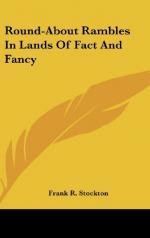Aunt Ann’s voice was nothing like so soft and gentle as a fairy’s, and it woke up little Bridget.
“You lovely dear!” cried her Aunt, “I hadn’t the least idea in the world that you were such a smart little thing, and there is no doubt but that you are now old enough to wash and dress yourself, and after this you may do it!”
So, after that, Bridget washed and dressed herself, and was just as happy as the birds, the butterflies, and flowers.
SOME NOVEL FISHING.
[Illustration]
Fishing has one great peculiarity which makes it often vastly more interesting than hunting, gunning, or many other sports of the kind, and that is that you never know exactly what you are going to get.
If we fish in waters known to us, we may be pretty sure of what we shall not get, but even in our most familiar creeks and rivers, who can say that the fish which is tugging at our line is certainly a perch, a cat-fish, or an eel? We know that we shall not pull up a shad or a salmon, but there is always a chance for some of those great prizes which are to be found, by rare good luck, in every river and good-sized stream; a rock-fish, or striped-bass perhaps, or a pike, or enormous chub.
But there are some fish which would not only gratify but astonish most of us, if we could be so fortunate as to pull them out of the water. For instance, here are some fish with both their eyes on one side of their heads.
[Illustration]
These are Turbots, and are accounted most excellent eating. They resemble, in their conformation but not in their color, our flounders or flat-fish, which some of you may have caught, and many of you have eaten. These fish lie on one side, at the very bottom of the water in which they live, and consequently one eye would be buried in the mud and would be of no use, if they were formed like common fish. But as their enemies and their food must come from above them, they need both their eyes placed so that they can always look upwards. In the picture at the head of this article, you will see some Soles lying together at the bottom. These are formed in the same way. They are white on one side, which is always down except when they are swimming about, and a very dark green on the other, so that they can scarcely be distinguished from the mud when they are lying at the bottom. The Turbot, however, as you see, is very handsomely spotted.
But there are much stranger fish than these flat fellows, and we must take a look at some of them. What would you say if you were to pull up such a fish as this on your hook?
[Illustration]
This is a Hippocampus, or sea-horse. He is a little fellow, only a few inches in length, but he is certainly a curiosity. With a head and neck very much like those of a horse, he seems to take pleasure in keeping himself in such a position as will enable him to imitate a high mettled charger to the greatest advantage. He curves his neck and holds up his head in a manner which few horses adopt, unless they are reined up very tightly. I have seen these little fellows in aquariums, and have always regarded them as the most interesting of fishes.




